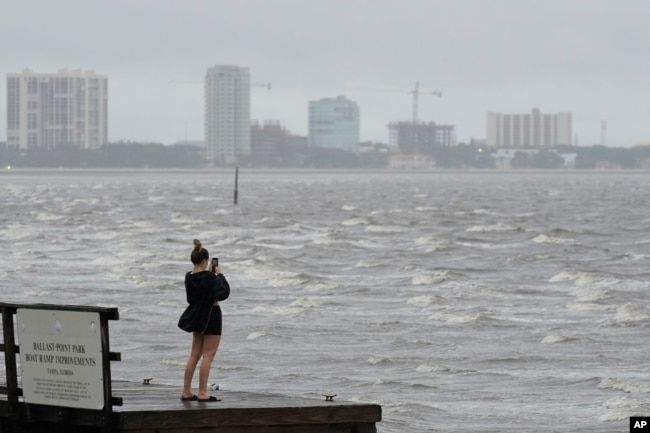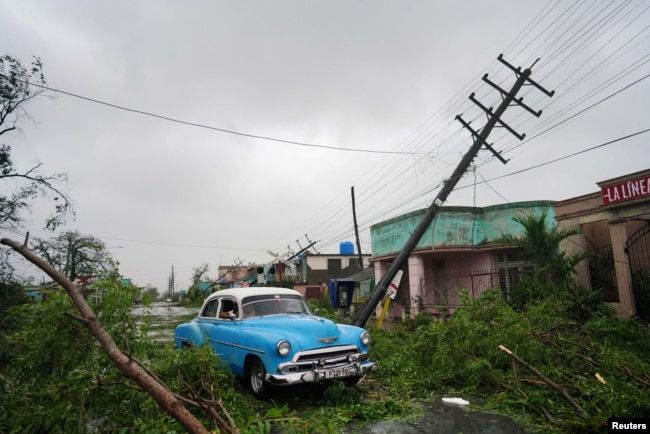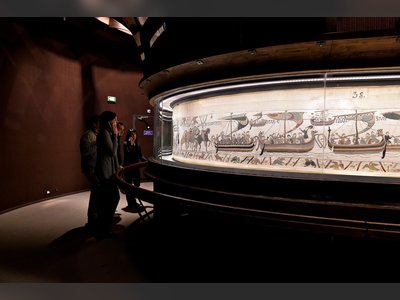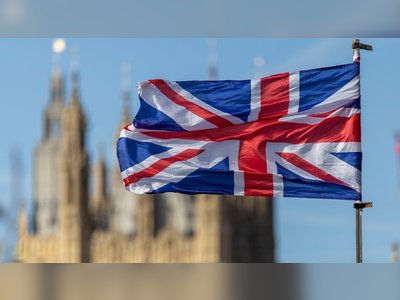
'Extremely Dangerous' Hurricane Ian Grows, Hits Florida
Forecasters say Ian came ashore Wednesday near Cayo Costa, along the southwestern coast of Florida, with maximum sustained winds of nearly 250 kilometers an hour, close to the threshold of becoming a Category 5 on the center’s five-level scale that measures a storm’s wind speed and destructive potential.
 An airplane overturned by a likely tornado
produced by the outer bands of Hurricane Ian is shown, Sept. 28, 2022,
at North Perry Airport in Pembroke Pines, Fla.
An airplane overturned by a likely tornado
produced by the outer bands of Hurricane Ian is shown, Sept. 28, 2022,
at North Perry Airport in Pembroke Pines, Fla.
More than 2 million residents on Florida’s west coast have been ordered to evacuate their homes, while Governor Ron DeSantis has activated thousands of National Guard troops as part of the state’s response. Disney World, Universal Studios and SeaWorld are among tourist attractions shutting down their popular theme parks and resorts. The U.S. space agency NASA has closed the visitor’s center at its Kennedy Space Center on Florida’s eastern coast, and has rolled its massive Artemis 1 moon rocket and Orion space capsule from its launch pad back to the Vehicle Assembly Building, further delaying its much anticipated test flight by several more weeks.
Thousands of flights have been canceled after several major airports in the expected path of the storm, including Tampa and St. Petersburg, shut down operations.
 A woman takes photos of the surf on Tampa Bay ahead of Hurricane Ian, Sept. 28, 2022, in Tampa, Fla.
A woman takes photos of the surf on Tampa Bay ahead of Hurricane Ian, Sept. 28, 2022, in Tampa, Fla.
Forecasters say Hurricane Ian is expected to cause life-threatening storm surges, catastrophic winds and flooding in the Florida peninsula, as well as considerable flash, urban and river flooding as it crosses central Florida Wednesday night and Thursday before reemerging over the western Atlantic Ocean. Ian is also expected to produce as much as 60 centimeters of rain from the Florida Keys and South Florida into the neighboring states of Georgia and South Carolina.
White House press secretary Karrine Jean-Pierre said Tuesday on Twitter that President Joe Biden had spoken to Governor DeSantis “to discuss the steps the federal government is taking to help Florida prepare for Hurricane Ian.” President Biden has issued an emergency declaration for Florida, authorizing the Federal Emergency Management Agency to coordinate disaster-relief efforts and provide more federal funding.
 A vintage car passes by debris caused by the Hurricane Ian as it passed in Pinar del Rio, Cuba, Sept. 27, 2022.
A vintage car passes by debris caused by the Hurricane Ian as it passed in Pinar del Rio, Cuba, Sept. 27, 2022.
The hurricane is heading toward Florida after making landfall Tuesday on western Cuba as a Category 3 storm. The storm killed two people and left the entire island without power after its aging electrical grid, which has been struggling to remain operational amid a dire economic crisis, collapsed late Tuesday.
Ian left behind a trail of destruction across Pinar del Rio province, Cuba’s main tobacco growing region, ripping the roofs off homes and buildings and making streets impassable from downed trees and power lines and flooding. Authorities evacuated as many as 40,000 people from low-lying areas of Pinar del Rio.











